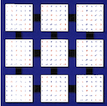1 SUBROUTINE pdsvdcmp( M, N, JOBTYPE, S, SC, U, UC, IU, JU, DESCU,
2 $ VT, VTC, IVT, JVT, DESCVT, THRESH, RESULT,
11 INTEGER IU, IVT, JOBTYPE, JU, JVT, LWORK, M, N
12 DOUBLE PRECISION DELTA, THRESH
15 INTEGER DESCU( * ), DESCVT( * ), RESULT( * )
16 DOUBLE PRECISION S( * ), SC( * ), U( * ), UC( * ), VT( * ),
176 INTEGER BLOCK_CYCLIC_2D, DLEN_, DTYPE_, CTXT_, M_, N_,
177 $ MB_, NB_, RSRC_, CSRC_, LLD_
178 parameter( block_cyclic_2d = 1, dlen_ = 9, dtype_ = 1,
179 $ ctxt_ = 2, m_ = 3, n_ = 4, mb_ = 5, nb_ = 6,
180 $ rsrc_ = 7, csrc_ = 8, lld_ = 9 )
183 INTEGER COLPTR, I, INFO, J, LWMIN, MYCOL, MYROW, NPCOL,
184 $ NPROW, NQ, RESULTS, SIZE, SIZEPOS, SIZEQ
185 DOUBLE PRECISION ACCUR, CMP, NORMDIFS, NORMDIFU, NORMDIFV,
190 DOUBLE PRECISION DLANGE, PDLAMCH, PDLANGE
191 EXTERNAL numroc, dlange, pdlamch, pdlange
201 IF( block_cyclic_2d*csrc_*dlen_*dtype_*mb_*m_*n_*rsrc_.LT.0 )
215 CALL blacs_gridinfo( descu( ctxt_ ), nprow, npcol, myrow, mycol )
216 IF( nprow.EQ.-1 )
THEN
219 CALL chk1mat( m, 1,
SIZE, sizepos, 1, 1, descu, 8, info )
220 CALL chk1mat(
SIZE, sizepos, n, 2, 1, 1, descvt, 11, info )
227 sizeq = numroc(
SIZE, descu( nb_ ), mycol, 0, npcol )
228 nq = numroc( n, descvt( nb_ ), mycol, 0, npcol )
229 lwmin =
max( sizeq, nq ) + 4
233 IF( lwork.LT.lwmin )
THEN
235 ELSE IF( thresh.LE.0 )
THEN
241 CALL pxerbla( descu( ctxt_ ),
'PDSVDCMP', -info )
245 ulp = pdlamch( descu( ctxt_ ),
'P' )
249 norms = dlange(
'1',
SIZE, 1, s,
SIZE, work )
251 sc( i ) = s( i ) - sc( i )
254 normdifs = dlange(
'1',
SIZE, 1, sc,
SIZE, work )
255 accur = ulp*size*norms*thresh
257 IF( normdifs.GT.accur )
259 IF( normdifs.EQ.0 .AND. accur.EQ.0 )
THEN
262 normdifs = normdifs / accur
265 IF( jobtype.EQ.2 )
THEN
267 result( 5 ) = results
270 colptr = descu( lld_ )*( j-1 )
271 DO 20 i = 1, descu( lld_ )
272 uc( i+colptr ) = u( i+colptr ) - uc( i+colptr )
276 normdifu = pdlange(
'1', m,
SIZE, uc, iu, ju, descu, work )
278 IF( normdifu.GE.accur )
280 IF( normdifu.EQ.0 .AND. accur.EQ.0 )
THEN
283 normdifu = normdifu / accur
286 ELSE IF( jobtype.EQ.3 )
THEN
288 result( 7 ) = results
291 colptr = descvt( lld_ )*( j-1 )
292 DO 40 i = 1, descvt( lld_ )
293 vtc( i+colptr ) = vt( i+colptr ) - vtc( i+colptr )
297 normdifv = pdlange(
'1',
SIZE, n, vtc, ivt, jvt, descvt, work )
299 IF( normdifv.GE.accur )
302 IF( normdifv.EQ.0 .AND. accur.EQ.0 )
THEN
305 normdifv = normdifv / accur
308 ELSE IF( jobtype.EQ.4 )
THEN
310 result( 9 ) = results
314 cmp =
max( normdifv, normdifu )
315 delta =
max( cmp, normdifs )
subroutine pdsvdcmp(m, n, jobtype, s, sc, u, uc, iu, ju, descu, vt, vtc, ivt, jvt, descvt, thresh, result, delta, work, lwork)

